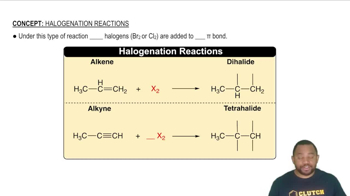Find and fix each mistake in the equilibrium constant expressions. a. 2 H2S(g) ⇌ 2 H2(g) + S2(g) K = [H2][S2]/[H2S]
Ethene (C2H4) can be halogenated by this reaction: C2H4(g) + X2(g) ⇌ C2H4X2(g) where X2 can be Cl2 (green), Br2 (brown), or I2 (purple). Examine the three figures representing equilibrium concentrations in this reaction at the same temperature for the three different hal- ogens. Rank the equilibrium constants for the three reactions from largest to smallest.

 Verified step by step guidance
Verified step by step guidance
Verified video answer for a similar problem:
Key Concepts
Equilibrium Constant (K)

Halogen Reactivity

Le Chatelier's Principle

Find and fix each mistake in the equilibrium constant expressions. b. CO(g) + Cl2(g) ⇌ COCl2(g) K = [CO][Cl2]/[COCl2]
When this reaction comes to equilibrium, will the concentrations of the reactants or products be greater? Does the answer to this question depend on the initial concentrations of the reactants and products? A(g)+B(g) ⇌ 2 C(g) Kc = 1.4⨉10-5
H2 and I2 are combined in a flask and allowed to react according to the reaction: H2(g) + I2(g) ⇌ 2 HI(g) Examine the figures (sequential in time) and answer the questions: a. Which figure represents the point at which equilibrium is reached?
A chemist trying to synthesize a particular compound attempts two different synthesis reactions. The equilibrium constants for the two reactions are 23.3 and 2.2⨉104 at room temperature. However, upon carrying out both reactions for 15 minutes, the chemist finds that the reaction with the smaller equilibrium constant produces more of the desired product. Explain how this might be possible.
This reaction has an equilibrium constant of Kp = 2.26⨉104 at 298 K. CO(g) + 2 H2(g) ⇌ CH3OH(g) Calculate Kp for each reaction and predict whether reactants or products will be favored at equilibrium. a. CH3OH(g) ⇌ CO(g) + 2 H2(g)
